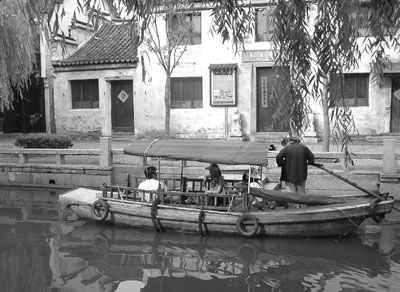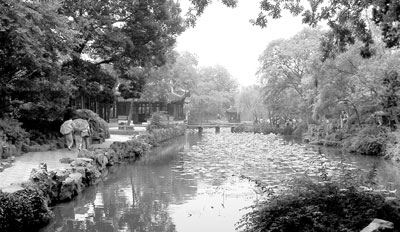Suzhou and Zhouzhuang — a delightful day trip from Shanghai
by Louis Bechtel, Rancho Palos Verdes, CA
In June ’05, after four days of sightseeing in Shanghai, one of the world’s most exciting cities, pulsating with energy and vitality, my son Jim and I decided it was time for a quiet respite to neighboring Suzhou and Zhouzhuang, two of China’s popular tourist cities. Both are within an hour of Shanghai by bus, train or tour coach.
Our Shanghai base, Marriott’s Renaissance Pudong Hotel, arranged a one-day tour of Suzhou and Zhouzhuang through Jin Jiang Optional Tours (www.jjtravel.com). With six other passengers, we traveled by air-conditioned tour coach with a well-trained and courteous English-speaking guide. At no time did we feel rushed, a frequent complaint of tour groups.
Suzhou
Founded in 514 B.C., Suzhou, with its 60 classical gardens and famous silk industry, is located 54 miles west of Shanghai. Rapid urbanization in the last decade has robbed Suzhou of some of its charm, but the gardens we visited were breathtaking.
The classical Humble Administrator’s Garden, the largest in Suzhou, dates back to 1513. It is focused on a central pond, with various pavilions, terraces and towers in a natural setting.
The Lion Forest Garden is noted for its labyrinthine trails, an intriguing maze of nine winding pathways, 21 caves and the treasured, grotesquely shaped perforated rocks called Taihu, from Lake Tai. The garden boasts 22 buildings of various designs.
The 7-story Tiger Hill Pagoda, built in A.D. 961, is one of Suzhou’s main attractions.
Our tour of Suzhou’s working No. 1 Silk Mill was well organized and covered the 5,000-year-old silk-making process, from mulberry tree to a fashion show of stunning silk gowns.
Top-quality silk quilts, duvet covers, pillow covers, exquisite embroideries and clothing are sold at an adjoining salesroom. Few people left there empty-handed. Merchandise can be shipped or conveniently packed for your carry-on luggage.
Renowned the world over for its elegance and beauty, Suzhou’s famous double embroidery has to be seen to be believed. Using a technique where stitching takes place on both sides of a single transparent silk fabric, craftswomen create entirely different pictures on either side. When embroidering areas that are differently colored, the artisan uses two needles with different colors, requiring intense concentration.
Prices vary with size, design and detail. Double embroideries I bought on past trips to China occupy a prominent place in my curio cabinet. Visit www. suembroidery.com for photos of the types of embroideries offered.
Zhouzhuang
Zhouzhuang, midway between Shanghai and Suzhou, is often considered one of the best waterside towns in China. Dating back more than 900 years, it combines a bit of Bruges with a bit of Venice. Well-preserved houses from the Ming and Qing dynasties (1368-1908), many with courtyards, and gondola rides along the canals attract 2.3 million visitors a year.
Fourteen distinct stone bridges link up households and shops along paths on both sides of the canal. Fu’an Bridge, Zhouzhuang’s oldest (1355), has towers on all four corners housing shops, restaurants and tearooms, and people the world over come to paint images of the famous Twin Bridge.
Gondolas, carrying a maximum of eight passengers, operate from 8 a.m. to 7 p.m.
Although it is often crowded with tour groups, I did not find the city touristy. There is a definite ambiance of the past there — it’s like walking through a museum. There were no aggressive touts peddling their wares, and gondoliers patiently waited their turns at the dock to take passengers aboard.
Locals wash clothes in the canal, shop for produce and meet with friends as they snack on steamed dumplings and green tea from nearby stalls.
When I passed through the decorative gateway as we left Zhouzhuang, part of me remained. I’d recommend a visit if you want to escape to a different place with a beauty and a beat all its own.
Arranging a visit
A day tour allows ample time to cover both Suzhou and Zhouzhuang. We were picked up at, and transferred back to, our Shanghai hotel. All admission fees and tour expenses, with a better-than-average Chinese lunch, were included. We paid $55 each for the trip.
Personalized trips cost $207 for one person or $122 each for two. You also can travel by train ($3.30 for the one-hour trip) to Suzhou on your own, but fees to enter Suzhou’s gardens ($5-$8 each) plus the $10 gondola boat ride in Zhouzhuang add to your expense.
This excursion was a highlight of our stay in Shanghai.



